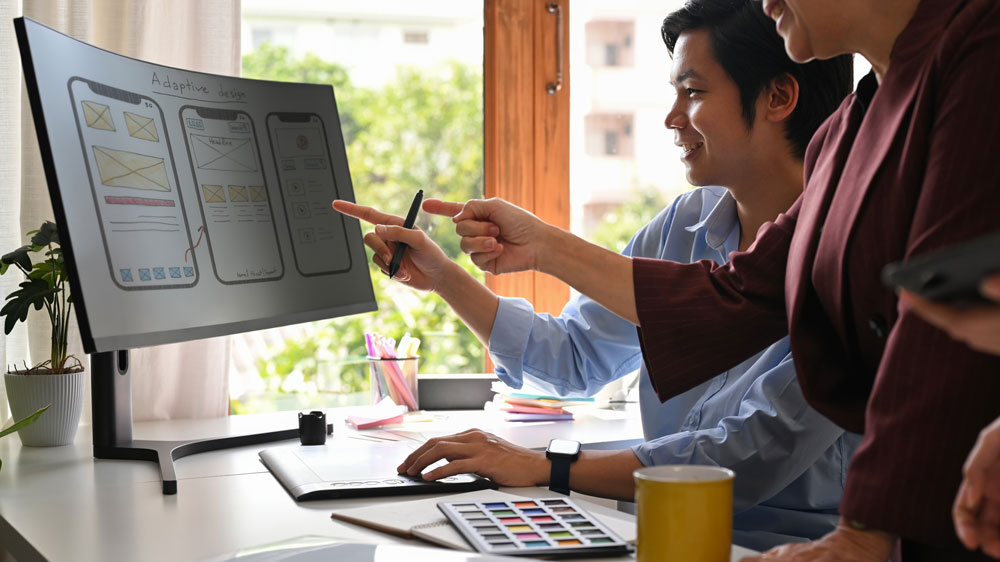How to Become an Interaction Designer? A Comprehensive Guide
Have you ever heard about interaction designers? What’s their role in the modern design industry? Let’s explore the profession’s basics, including where to study it. Also, we’ll inspect the modern online and offline tools you could use as an interaction designer.
What is an Interaction Designer profession?
It is a professional who is in charge of designing the usability of apps, site,s or any software that exists on mobile devices. Most of them are aimed enhance the user experience
We may compare interaction designers with architects. For example, an architect should be able to see from different angles how people would use the future building, its parking, elevators, or stairways. Similarly, interaction designers create solutions for how we interact with websites, apps, and gadgets.
What do Interaction Designers do?
They ensure that an average user is happy with a website, mobile or a desktop app, meaning they can easily register, make a purchase, and find an answer to any question. They take care of the buttons you press, the menus you open, and pretty much all the elements of the page. It’s their responsibility to find the perfect shape of each element and put it in its best place.
Their duties are:
- User Research They conduct research regularly to understand the needs, preferences, and behaviors of the target audience. They gather surveys, interviews, and commit user testing.
- Creating User Personas In order to know more about their users and their path, they create ideal images of average customers.
- Wireframing and Prototyping They design sketches or interactive prototypes to visualize the product in terms of layout and general use.
- Information Architecture They organize content and features in a logical way to make effective navigation for users.
- User Interface Design They design the user interface itself, namely buttons, icons, color schemes, and typography. The goal is to create an interface that is not only aesthetically pleasing but also enhances the user experience.
- Interaction Design They define how users interact with the product. They create user flows, transitions, animations, and feedback mechanisms.
- Usability Testing A good specialist has to conduct tests with real users to gather feedback. That’s how they identify areas for improvement in the product's design and functionality.
- Collaboration That means working closely with other team members like developers and SEO specialists to ensure the design is implemented correctly.
- Iteration They repeatedly update their designs according to trends and new technical possibilities. They collect feedback from users.
There might be some other responsibilities but the main ones we’ve covered.

Interaction Design Evaluation Parameters
Here are the most important aspects that interaction designers consider while working on a project:
Texts
When communicating with users, it's important to pick up the right words. This includes labels on buttons, forms, and error messages. When something goes wrong, a user should be able to get instructions that guide them through. All word-based elements should be revised and should be grammatically correct.
The choice of words is critical. Sentences should be clear, concise, and straight to the point. We don’t want to confuse a user or waste their time.
Visual Elements
This includes buttons, menus, icons, illustrations, photos and any graphical elements. Interaction designers should ensure that these elements are not only pleasing, but also reasonably placed and function correct.
Physical Objects
Considering keyboards, mice, and touchscreens is also important. Interaction designers should think of how these physical objects function and how they influence the overall user experience.
For example, for some interface actions on mobile devices, people prefer to use their thumbs. The main button (for example the one called “Buy”) has to be reachable by a thumb in this case.
Time
Time is a significant factor in interaction design. Consider the timing of events and interactions within the digital product.
Think of the speed at which the main actions are processed, the timing of animations and transitions. Ask yourself, how long does it take for an average user to register on the platform? Proper timing means that users don't get frustrated by slow interactions.
Behavior
When a user clicks a button, how does the system respond? Is there a hover before? Is there an indication after a click? Maybe the button needs a tooltip nearby explaining its function?
To sum it up, let's say that interaction designers should create responsive and predictable behavior.
What is the difference between interaction design and visual design?
Interaction design and visual design are two distinct but closely related aspects of the user experience design process, and they collaborate to create high-quality digital products.
Although they are close to each other, they focus on different things:
Interaction Design focused on:
- Interactions with users.
- Organizing the product in an easy-to-understand manner
- Functioning, interface and structure
Visual Design focused on:
- The product looks including color palette, typeface, images, and logos
- A combination of both leads us to a successful product.
Where to Learn Interaction Design?
You can get a formal degree by attending a design school, or take online classes or courses. Also, you can study by yourself by reading dedicated books, watching YouTube skill-sharing clips and joining online communities.
Formal Education
In North America, there are many schools to choose from. In Canada, you can go to George Brown College in Toronto to get an Advanced Diploma in Interaction Design. Also, you may consider Fanshawe College in London, Canada to get a Diploma of Interactive Media Design. In North Vancouver you can study design at Capilano University.
Online Courses
These are some free courses that are related to interaction design. The great volume is available on platforms such as Coursera, Udemy or Skillshare that offers paid and unpaid classes. Also, check universities that provide distance learning, like Daytona State College in the USA, where you can study Digital and Interactive Media Production in a 2-year period.
Books and Articles
Subsequently, reading books and articles will enable you to gain adequate understanding of interaction design.
Some good reads are:
-
Interaction Design: Beyond Human-Computer Interaction written by Alan Cooper
-
The Design of Everyday Things. Book by Don Norman.
-
There is a good article titled “This Is Service Design Thinking,” written by Jakob Schneider.
Online Communities
You can join online groups and forums where interaction designers chat and share knowledge. It’s a good way to learn from real examples and discussions. Have you ever heard about the Interaction Design Association (IDA)? Check their website as well. Another place to connect with other designers is the Design Better community.
On-the-job experience
If you can find a job that lets you work on interaction design projects, that's a fantastic way to learn.

Interaction Designers Salary in Canada
It depends on location, experience, and the industry you work in.
- Entry-Level Salaries: CAD 50,000 to 70,000 per year
- Mid-Level Salaries: CAD 70,000 to 90,000 per year
- Senior-Level Salaries: CAD 100,000 or more per year.
Interaction Designers Salary in Vancouver
Vancouver is a well-known center of technology and design. It offers competitive salaries for Interaction Designers. The average salary for an Interaction Designer in Vancouver is typically higher than the national average.
- Entry-Level Salaries: CAD 55,000 to 75,000 per year
- Mid-Level Salaries: CAD 75,000 and 95,000 annually
- Senior-Level Salaries: CAD 105,000 annually
As they say: “One day, all your hard work will pay off.” Let’s be inspired and honest in our daily working.
Tools for Learning Interaction Design
To work effectively as an interaction designer, you need the right tools.

Wireframing Tools
Wireframing means creating simple representations or stages of your design. Wireframes represent outlines of the very basic look of paths the user will take. It looks like a sequence of screens.
1. Sketch is a very simple to use app widely known for its user-friendly interface. It offers a variety of features that make it ideal for wireframing:
Shapes and signs can be used in wireframes, including rectangles, circles, polygons and others.
2. Figma is a popular wireframe tool that is known for its collaborative features. It enables users to work on wireframes together in real time. Figma has a browser-based version so you don’t have to install it.
- A wide range of templates and wireframe kits
- The ability to create an interactive prototype
- Huge number of plugins
3. Adobe XD is a versatile wireframing tool that is part of the Adobe Creative Cloud suite. It offers a variety of features that make it ideal for wireframing.
4. Framer is a great modern tool with an AI feature to design websites. While you create a layout, the system writes code automatically. When you are satisfied with the design result, just click “Publish,” and your website is officially on the Internet.
Prototyping Tools
These are the tools that help you create high-fidelity prototypes of your designs that can be tested by users. Compared to wireframes, prototypes are more realistic and can give users a better idea of how the final product will look and work.
Axure RP is a powerful tool that allows users to create high-fidelity prototypes with complex interactivity. Frequently used by design teams worldwide. You can create prototypes for software applications such as websites and mobile apps in it.
Framer is also a prototyping tool, which is flexible and powerful as well. You don’t have to know coding to make complex interface solutions in it.
Invision Studios is relatively easy-to-use. It has a stand out feature of being a collaborative tool. However, what makes it unique is the fact that users can actually develop fully functional and clickable prototypes without the help of coding languages. Here you can create an interface paradigm for websites, mobile applications, and presentations.
ProtoPie is a tool for building prototypes that is also characterized by the possibility of creating realistic prototypes with animation effects and many interactions.

Pick up the one that suits you best.
User Behavior Research Tools
Google Forms is a web-based data collection tool that is used to poll the users for information. It’s not only easy to use, but it also provides a feature choice.
SurveyMonkey provides the ability to create more complex surveys with branching logic. It collects data from mobile users, and enables the analysis of survey results with advanced features.
UserTesting.com is a user research tool that allows you to watch videos of users while they interact with your product. This can be a valuable way to find any usability problems.
UsabilityHub is another good user research tool for collecting feedback from users on your product or prototype. It offers a variety of tests, such as five second tests, click tests, and tree tests.
Crazy Egg is a user research tool that allows you to see how users interact with your website. It shows you heatmaps and scroll maps so you can get the idea of where users are clicking, scrolling, and dropping off.
These are just a few of the many user research tools that are available. Some of these services are free, others require a subscription.
Conclusion
Interaction designers have the power to make a real difference in the world, and it is a rewarding career path for those who are passionate about making tech work. For Interaction Designer job opportunities, create your profile on Djobzy.com. We’ll inform you in case of any job that involves interaction design.
Good luck in your design career!
For Interaction Designer job opportunities, check out Djobzy.
Read More: Restaurant General Manager Skills: What You Need to Know
Blog Categories
Forum
-
...








